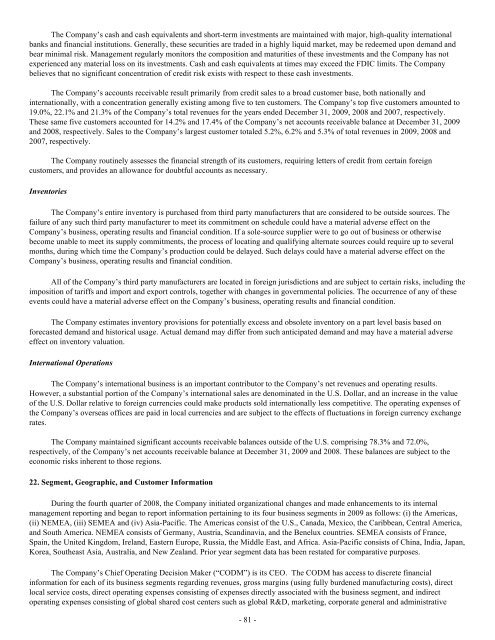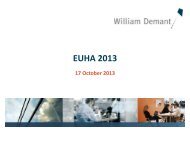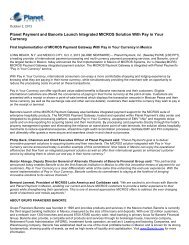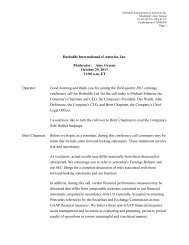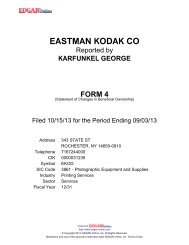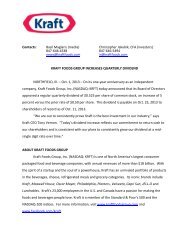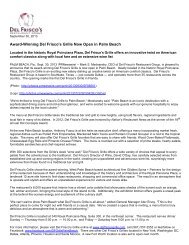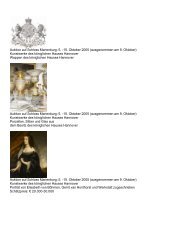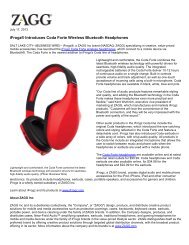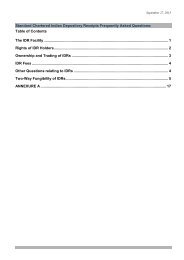Hypercom Corporation Annual Report - CiteSeer
Hypercom Corporation Annual Report - CiteSeer
Hypercom Corporation Annual Report - CiteSeer
You also want an ePaper? Increase the reach of your titles
YUMPU automatically turns print PDFs into web optimized ePapers that Google loves.
The Company’s cash and cash equivalents and short-term investments are maintained with major, high-quality international<br />
banks and financial institutions. Generally, these securities are traded in a highly liquid market, may be redeemed upon demand and<br />
bear minimal risk. Management regularly monitors the composition and maturities of these investments and the Company has not<br />
experienced any material loss on its investments. Cash and cash equivalents at times may exceed the FDIC limits. The Company<br />
believes that no significant concentration of credit risk exists with respect to these cash investments.<br />
The Company’s accounts receivable result primarily from credit sales to a broad customer base, both nationally and<br />
internationally, with a concentration generally existing among five to ten customers. The Company’s top five customers amounted to<br />
19.0%, 22.1% and 21.3% of the Company’s total revenues for the years ended December 31, 2009, 2008 and 2007, respectively.<br />
These same five customers accounted for 14.2% and 17.4% of the Company’s net accounts receivable balance at December 31, 2009<br />
and 2008, respectively. Sales to the Company’s largest customer totaled 5.2%, 6.2% and 5.3% of total revenues in 2009, 2008 and<br />
2007, respectively.<br />
The Company routinely assesses the financial strength of its customers, requiring letters of credit from certain foreign<br />
customers, and provides an allowance for doubtful accounts as necessary.<br />
Inventories<br />
The Company’s entire inventory is purchased from third party manufacturers that are considered to be outside sources. The<br />
failure of any such third party manufacturer to meet its commitment on schedule could have a material adverse effect on the<br />
Company’s business, operating results and financial condition. If a sole-source supplier were to go out of business or otherwise<br />
become unable to meet its supply commitments, the process of locating and qualifying alternate sources could require up to several<br />
months, during which time the Company’s production could be delayed. Such delays could have a material adverse effect on the<br />
Company’s business, operating results and financial condition.<br />
All of the Company’s third party manufacturers are located in foreign jurisdictions and are subject to certain risks, including the<br />
imposition of tariffs and import and export controls, together with changes in governmental policies. The occurrence of any of these<br />
events could have a material adverse effect on the Company’s business, operating results and financial condition.<br />
The Company estimates inventory provisions for potentially excess and obsolete inventory on a part level basis based on<br />
forecasted demand and historical usage. Actual demand may differ from such anticipated demand and may have a material adverse<br />
effect on inventory valuation.<br />
International Operations<br />
The Company’s international business is an important contributor to the Company’s net revenues and operating results.<br />
However, a substantial portion of the Company’s international sales are denominated in the U.S. Dollar, and an increase in the value<br />
of the U.S. Dollar relative to foreign currencies could make products sold internationally less competitive. The operating expenses of<br />
the Company’s overseas offices are paid in local currencies and are subject to the effects of fluctuations in foreign currency exchange<br />
rates. The Company maintained significant accounts receivable balances outside of the U.S. comprising 78.3% and 72.0%,<br />
respectively, of the Company’s net accounts receivable balance at December 31, 2009 and 2008. These balances are subject to the<br />
economic risks inherent to those regions.<br />
22. Segment, Geographic, and Customer Information<br />
During the fourth quarter of 2008, the Company initiated organizational changes and made enhancements to its internal<br />
management reporting and began to report information pertaining to its four business segments in 2009 as follows: (i) the Americas,<br />
(ii) NEMEA, (iii) SEMEA and (iv) Asia-Pacific. The Americas consist of the U.S., Canada, Mexico, the Caribbean, Central America,<br />
and South America. NEMEA consists of Germany, Austria, Scandinavia, and the Benelux countries. SEMEA consists of France,<br />
Spain, the United Kingdom, Ireland, Eastern Europe, Russia, the Middle East, and Africa. Asia-Pacific consists of China, India, Japan,<br />
Korea, Southeast Asia, Australia, and New Zealand. Prior year segment data has been restated for comparative purposes.<br />
The Company’s Chief Operating Decision Maker (“CODM”) is its CEO. The CODM has access to discrete financial<br />
information for each of its business segments regarding revenues, gross margins (using fully burdened manufacturing costs), direct<br />
local service costs, direct operating expenses consisting of expenses directly associated with the business segment, and indirect<br />
operating expenses consisting of global shared cost centers such as global R&D, marketing, corporate general and administrative<br />
- 81 -


